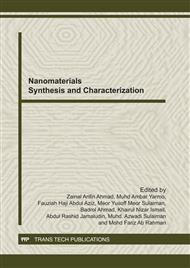p.1
p.7
p.12
p.16
p.20
p.25
p.30
p.35
Effect of Oxygen Flow Rate on the Properties of Nanocolumnar ZnO Thin Films Prepared Using Radio Frequency Magnetron Sputtering System for Ultraviolet Sensor Applications
Abstract:
Nanostructured zinc oxide (ZnO) thin films were deposited on glass substrates using radio frequency (RF) magnetron sputtering system at different oxygen flow rates ranges between 0 to 40 sccm. Field emission scanning electron microscopy (FESEM) images was revealed that nanocolumnar ZnO structure thin films are produced on the substrates using high purity ZnO as the target at RF power of 250 W in the argon and oxygen gas mixture ambient. The XRD spectra reveal that the deposited films are preferentially grown along the c-axis indicating high ZnO crystallinity. The ultraviolet-visible (UV-Vis) spectra show that all samples are very transparent in the visible region (400 – 800 nm) with average transparency above 80 %. The photocurrent properties indicate that ZnO thin film prepared at oxygen flow rate of 20 sccm has the optimum characteristic for ultraviolet sensor applications. This finding suggested that the oxygen flow rates play important role and has critical value for semiconducting nanocolumnar ZnO growth in the sputtering system, which can produce ZnO thin film with high sensitivity of ultraviolet detection.
Info:
Periodical:
Pages:
1-6
Citation:
Online since:
October 2011
Price:
Сopyright:
© 2012 Trans Tech Publications Ltd. All Rights Reserved
Share:
Citation:


